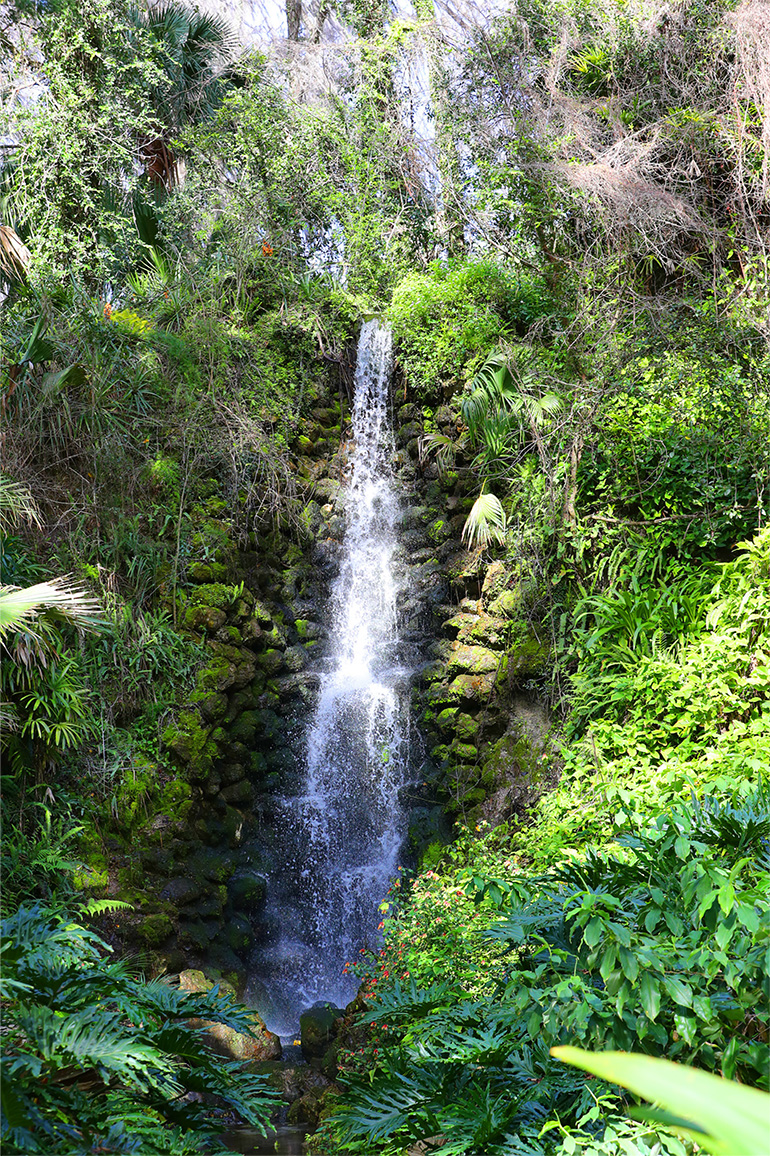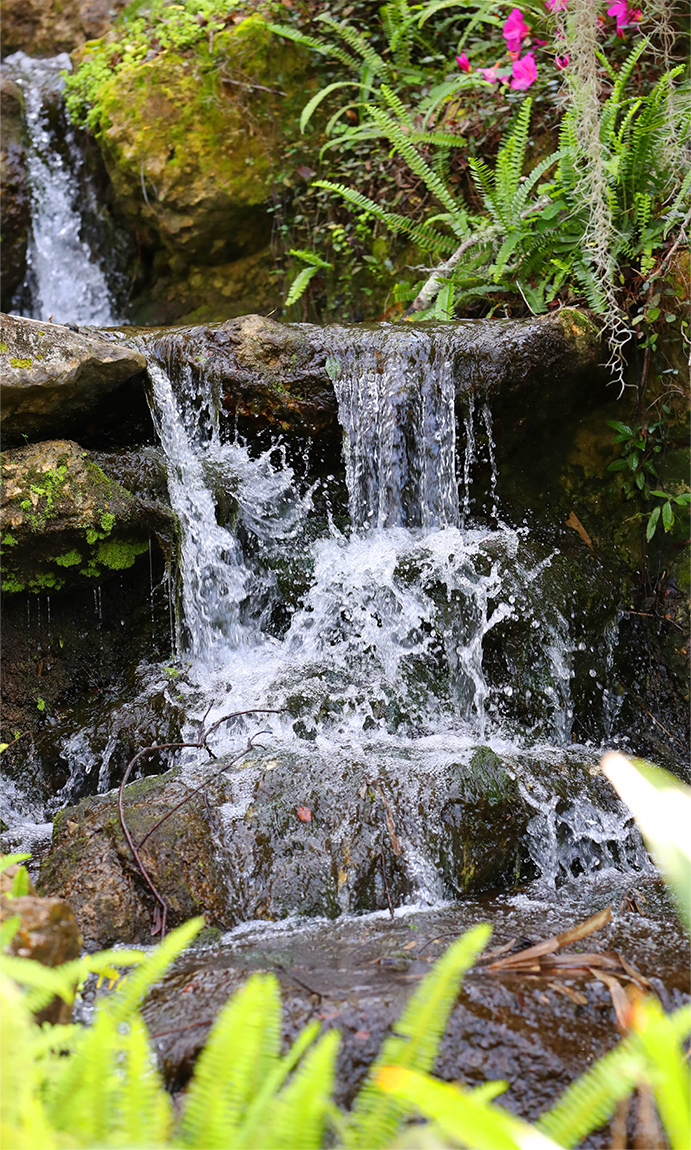The beloved manmade water features at Rainbow Springs State Park have been given new life through the efforts of a small but devoted group of volunteers.

Waterfalls provide some of nature’s most pleasing sights and sounds. But sometimes, a manmade waterfall needs a friend—make that a Friend.
The Friends of Rainbow Springs State Park have made it their mission to restore the Rainbow, Seminole and Aviary waterfalls inside one of the most unique and gorgeous parks in Florida. It has been a labor of love for the volunteer group, whose numbers were seriously decimated during the pandemic.

Now, visitors to the park need only pass through the headsprings entrance pavilion and turn to the left to ascend at slight angles through massive and, in spring, glorious banks of old growth azaleas in shades of salmon, white, deep purple and fuchsia, to wend one’s way to the flow of water falling smoothly over stones and deep emerald moss in the storied trio of waterfalls.
Here, you can leave behind highway noises and relax in the lap of nature as you take in the birdsong, gentle breezes, filtered sunlight and that lovely, soothing sound of running water.
What you will find today is a far cry from the “attraction” of yesteryear, which included a rodeo, a small zoo and several boat rides, including sub-boats with stairs that went below the waterline so visitors could look out at eye level.

“If you are looking for a beautiful park, you will find it at Rainbow Springs State Park,” states Park Manager Kathleen Kelso. “Once a privately owned roadside attraction, Rainbow Springs State Park offers many enjoyable outdoor opportunities including jogging the trails, meditating by a peaceful waterfall or admiring the lovely flowers. Rainbow Springs contains the fourth largest first-magnitude spring in Florida, pumping more than 65 million gallons of water a day. The park also offers a glimpse into the early Paleo-Indian history of the area and a habitat that supports an impressive range of imperiled species.”
Rainbow Springs State Park was acquired in 1990 with funds from the Conservation and Recreational Lands program. The park spans 1,694 acres and annually hosts around 330,000 visitors from around the world. The crystal-clear Rainbow River flows from the headsprings and travels for nearly six miles until it merges with the Withlachoocee River, which is dark with tannins.

The Friends of Rainbow Springs State Park, Inc. (FORS), promotes the park and assists in the Florida Park Service’s mission of providing resource-based recreation while preserving, interpreting and restoring natural and cultural resources. The volunteer effort at the park began in 1990, following the purchase of the former commercial attraction, notes FORS Vice President Stasha McKnight.
“Volunteers cleared the old gardens of more than 15 years of debris, weeds and exotic plant growth, uncovering walkways throughout the park area,” McKnight shares. “They also did repairs to make facilities usable and bring life back to the gardens and other features. In 1992, the volunteers were allowed to open the park on weekends. By 1993, state funding allowed for park staff to join the volunteers. On March 9, 1995, the Florida Park Service opened Rainbow Springs State Park to the public on a full-time basis.”
McKnight says the park’s waterfalls, which date back to the 1930’s, were inoperable for about three years until the FORS group decided to restore them.
“The state was going to help us pay for the waterfalls, but the hurricanes hit, so those funds were redirected,” she explains. “So, we are using money raised from the gift shop, FORS memberships and donations to get the waterfalls fixed. The project will cost around $100,000. And we still have some issues to take care of, such as some of the ponds need to be sealed, and general repairs, along with the cost to maintain the waterfalls for generations to come.”
McKnight offers some insight into the origins of the three waterfalls, which are powered by pumps that draw water from the river and sends it through holding ponds before it cascades down the elevations and back into the basin below.

“Rainbow Falls is Florida’s highest manmade waterfall cascade at 60 feet. There was a grand opening on March 14th, 1937,” she shares. “The celebration included a Timucuan Indian Pageant with a Sun Dance and Water God ritual and there was a water carnival with a movie mermaid revue, exhibition swimming, fancy diving by Newt Perry’s aquatic stars, lifesaving demos, canoe tilting, clown diving and alligator wrestling by Harold Williams and a 10-foot gator.”
The celebration also included “Pee-wee the circus clown and his dog Rex, the University of Florida swim team, and demos. They also celebrated the 50th anniversary of the discovery of phosphate. There was lunch, soft drink stands, facilities for dancing, and free admission and parking.”
McKnight notes that Seminole Falls, the second tallest of the three, was created later that year by using soil dredged from nearby phosphate pits. It wasn’t until the 1970’s that Aviary Falls came about.

“Aviary Falls was once in the bird habitat/flight cage filled with exotic birds like toucans and peacocks, which was the world’s tallest aviary at the time,” McKnight offers. “And visitors were able to get close up with the birds by going for a ride on the Forest Flight Monorail, which was used to transport them through the park at tree level.”
Walking the waterfalls trail on a recent day, McKnight says she finds that the park is “one of the most amazing places. This park is unique because this spring consists of at least 87 known vents. There are all different crevasses from here to a mile and half down the river, and we are an aquatic preserve.”
A portion of the headsprings is designated for swimming and vessels such as kayaks, canoes and stand-up paddleboards can come upriver and maneuver around the roped off swimming area. Tubing is a popular activity on the Rainbow River and there are two options available, for a two-hour float or a four-hour excursion.

McKnight says the Friends group saw a significant decline in volunteers “once COVID hit. But we are starting to see more volunteers,” she adds.
Coming around the corner to approach Rainbow Falls, McKnight encounters two plein air painters—Sharon Crute and Renee St. Leger.
“You’ve really made improvements,” Crute offers.

“We really are trying to save the natural and cultural resources,” McKnight says to the painters. “People who have lived here forever have so many treasured memories here. They come here and bring pictures and it’s neat to see historical pictures of their grandfather in front of the waterfall or they spent their honeymoon here when we had little cottages. It’s an amazing place and you capturing the spirit and beauty of it is amazing.”
“This could take us all day,” St. Leger responds, dabbing a brush on her canvas.
Continuing the trek to view the falls, McKnight offers, “This used to be the town of Juliette in the 1800s. They had the Blue Hotel at the headsprings, had a gazebo where they danced every night. The rooms were $2 apiece and it was $1 for a boat ride. In the 1800s’ they had phosphate pits and when you take the two-mile hike, you will see remnants of two phosphate pits and all of this is made from the phosphate pilings. They had a railroad that came through there, they had a store, a post office… all that went away when the boom of the phosphate went away.”
Archaeological evidence indicates people have been using Rainbow Springs for nearly 10,000 years. At one time, mastodon and mammoth fossils were found in the Rainbow River, along with relics of Native Americans who used the river for transportation and fishing.
The Rainbow River and Rainbow Springs were recognized by the state when the system was designated an aquatic preserve in 1986 and an Outstanding Florida Water in 1987. In 1972, Rainbow Springs was designated a Registered Natural Landmark by the U.S. Department of the Interior National Park Service.

“Our springs have been referred to as ‘liquid bowls of light.’ When you visit Rainbow Springs, you never leave unchanged,” says Aquatic Preserve Manager Jeff Sowards.
The park is located at 10830 SW 180th Avenue Road, Dunnellon. The headsprings site is open 8am to sunset 365 days a year. Admission is $2 per person (free for ages 5 and younger). There are additional fees for activities such as vessel rental, tubing and camping. The park offers a concession stand, pavilions and restrooms.
Whether you visit Rainbow Springs State Park to walk, hike, swim, paddle, picnic or just sit in quiet contemplation, you are sure to find nature in all its splendor.
However, McKnight points out with obvious pride, “It just wasn’t the same without the waterfalls. People just didn’t get the peaceful feeling that the waterfalls bring.” OS
To learn more, visit floridastateparks.org/parks-and-trails/rainbow-springs-state-park and friendsofrainbowsprings.org






